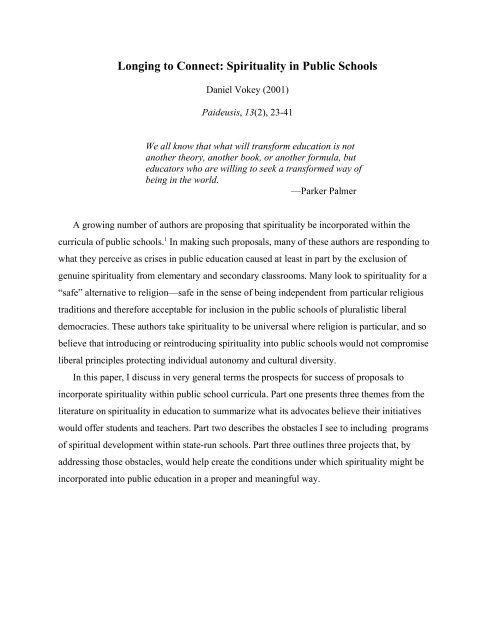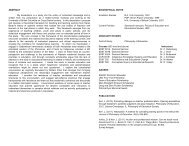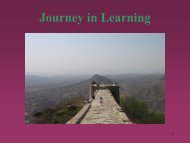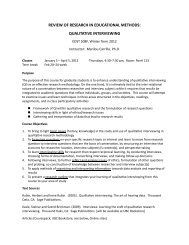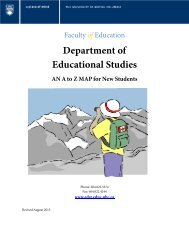Longing to Connect: Spirituality in Public Schools - Department of ...
Longing to Connect: Spirituality in Public Schools - Department of ...
Longing to Connect: Spirituality in Public Schools - Department of ...
Create successful ePaper yourself
Turn your PDF publications into a flip-book with our unique Google optimized e-Paper software.
WHAT WILL SPIRITUALITY OFFER STUDENTS AND TEACHERS?Theme 1: Renewed Life, Energy, and EnthusiasmFor many advocates <strong>of</strong> spirituality, the crisis <strong>of</strong> public school<strong>in</strong>g is that classes are deadlydull. They are deadly dull for students, and deadly dull for teachers. I use the modifier deadlyadvisedly, because dead is how students typically are described when they have lost their sense<strong>of</strong> wonder and with it their enthusiasm for learn<strong>in</strong>g. Fox (1998, p. 50) states that “The modernage and its forms <strong>of</strong> education and mass media can readily kill awe. . . . Education that ignoresawe kills the soul.” Similarly, Parker Palmer (1999, pp. 17-19) describes public school<strong>in</strong>g as“death-deal<strong>in</strong>g” precisely because “we have driven the sacred out <strong>of</strong> it.”One way <strong>in</strong> which spirituality <strong>in</strong> public school<strong>in</strong>g would seek <strong>to</strong> res<strong>to</strong>re life, energy, andenthusiasm <strong>to</strong> classrooms is <strong>to</strong> spark student curiosity. As Albert E<strong>in</strong>ste<strong>in</strong> suggests, wonder andawe might be fostered by <strong>in</strong>vit<strong>in</strong>g students <strong>to</strong> step <strong>to</strong> the edge <strong>of</strong> human knowledge and peer <strong>in</strong><strong>to</strong>the mystery beyond:The most beautiful and pr<strong>of</strong>ound emotion we can experience is the sensation <strong>of</strong> themystical. It is the source <strong>of</strong> all true science and art. We <strong>to</strong> whom this emotion is astranger, who can no longer wonder and stand rapt <strong>in</strong> awe, are as good as dead. To knowthat what is impenetrable <strong>to</strong> us really exists, manifest<strong>in</strong>g itself as the highest wisdom andthe most radiant beauty which our dull faculties can comprehend only <strong>in</strong> their mostprimitive forms—this knowledge, this feel<strong>in</strong>g is at the centre <strong>of</strong> true religiousness.(E<strong>in</strong>ste<strong>in</strong>, cited <strong>in</strong> COBWS, 1982, p. 150)For those who are not sure how or even whether we should <strong>in</strong>duce mystical experiences <strong>in</strong> theclassroom, less esoteric ways have also been proposed <strong>to</strong> <strong>in</strong>spire wonder and awe <strong>in</strong> students and<strong>to</strong> res<strong>to</strong>re their enthusiasm for learn<strong>in</strong>g. Some <strong>of</strong> these <strong>in</strong>volve teachers simply encourag<strong>in</strong>gstudents <strong>to</strong> slow down and “smell the roses”—or the lilacs, as the case may be (Sche<strong>in</strong>dl<strong>in</strong>,1999). Some authors rem<strong>in</strong>d us that there is no need <strong>to</strong> <strong>in</strong>stil a sense <strong>of</strong> mystery <strong>in</strong> youngerchildren, as most will br<strong>in</strong>g their natural curiosity and thirst for learn<strong>in</strong>g with them <strong>to</strong> school.The follow<strong>in</strong>g poem illustrates this well:2
I am a be<strong>in</strong>g <strong>of</strong> life—striv<strong>in</strong>g <strong>to</strong>ward recognition and enlightenmentI have been shaped by the moonlight and bathed <strong>in</strong> stardustMy life began <strong>in</strong> the womb <strong>of</strong> a great woman the bearer <strong>of</strong> all th<strong>in</strong>gs wonderful and sweetRaised on dewdrops and m<strong>in</strong>t, I have learned <strong>to</strong> fly on my own two beautiful w<strong>in</strong>gs.A deep cavernous well is my m<strong>in</strong>d with little drops <strong>of</strong> knowledge fall<strong>in</strong>g <strong>in</strong> one by oneThe sound <strong>of</strong> my passion for life reverberates through my entire soul.I am myself and I am all. (Charlotte Langley, cited <strong>in</strong> Barnes, 2000)Particularly <strong>in</strong> the early grades, the task fac<strong>in</strong>g teachers is not so much <strong>to</strong> create ex nihilo a sense<strong>of</strong> wonder and awe <strong>in</strong> students as <strong>to</strong> keep school<strong>in</strong>g from kill<strong>in</strong>g their natural energy andcuriosity. 2Some <strong>of</strong> the authors concerned about low energy <strong>in</strong> classrooms l<strong>in</strong>k it <strong>to</strong> a lack <strong>of</strong> higherpurpose for school learn<strong>in</strong>g. They protest that contemporary curricula stifle wonder, awe, andcuriosity by requir<strong>in</strong>g students <strong>to</strong> absorb fragments <strong>of</strong> unconnected <strong>in</strong>formation, which students(and even teachers) experience as mean<strong>in</strong>gless (cf. Iannone & Iannone, 1999, p. 738). Studentsare not encouraged <strong>to</strong> ask the “big questions” about what life and learn<strong>in</strong>g are all about, andteachers (not without reason)<strong>of</strong>ten avoid such questions, and the controversies that go with them,like the proverbial plague (Kessler, 1998, p. 51). On this account, then, students and teachers<strong>of</strong>ten f<strong>in</strong>d school<strong>in</strong>g deadly dull because they perceive no <strong>in</strong>tr<strong>in</strong>sic mean<strong>in</strong>g <strong>in</strong> what they arerequired <strong>to</strong> do. To quote Palmer aga<strong>in</strong>:When we fail <strong>to</strong> honor the deepest questions <strong>of</strong> our lives, education rema<strong>in</strong>s mired <strong>in</strong>technical triviality, cultural banality, and worse: it cont<strong>in</strong>ues <strong>to</strong> be dragged down by agreat sadness. I mean the sadness one feels <strong>in</strong> <strong>to</strong>o many schools where teachers andstudents alike spend their days on th<strong>in</strong>gs unworthy <strong>of</strong> the human heart—a grief that maymask itself as boredom, sullenness, or anger, but that is, at bot<strong>to</strong>m, a cry for mean<strong>in</strong>g. 3Postman (1995, p. 4) shares a similar observation about the loss <strong>in</strong> our schools <strong>of</strong> a sharednarrative about the <strong>in</strong>tr<strong>in</strong>sic value or higher purposes <strong>of</strong> education: “Without a narrative, life hasno mean<strong>in</strong>g. Without mean<strong>in</strong>g, learn<strong>in</strong>g has no purpose. Without a purpose, schools are houses3
<strong>of</strong> detention, not attention.”Some proponents <strong>of</strong> spirituality <strong>in</strong> schools argue that the boredom and mean<strong>in</strong>glessnessstudents experience compels them <strong>to</strong> seek excitement <strong>in</strong> danger or an outlet for their frustration<strong>in</strong> aggressive behaviour. Kessler (1998, p. 49), for example, claims that “Drugs, sex, gangviolence, and even suicide may be both a search for connection and mean<strong>in</strong>g and an escape fromthe pa<strong>in</strong> <strong>of</strong> not hav<strong>in</strong>g a genu<strong>in</strong>e source <strong>of</strong> spiritual fulfilment.” On the flip side, Kazanjian(1998) reports that curricula which help students make connections between school<strong>in</strong>g and “reallife” are experienced as mean<strong>in</strong>gful, <strong>in</strong>spir<strong>in</strong>g, and even joyful. In particular, lessons ordiscussions that encourage students <strong>to</strong> grapple with the “big questions” at the centre <strong>of</strong> their livesare recommended as a way <strong>to</strong> br<strong>in</strong>g “soul” back <strong>to</strong> the classroom (Kessler, 1999). For those <strong>of</strong> uswho might worry that provid<strong>in</strong>g a higher purpose <strong>to</strong> learn<strong>in</strong>g will <strong>in</strong>volve impos<strong>in</strong>g some masternarrative on students, Palmer (1998, p. 8) reassures us that “spiritual men<strong>to</strong>r<strong>in</strong>g is not aboutdictat<strong>in</strong>g answers <strong>to</strong> the deep questions <strong>of</strong> life. It is about help<strong>in</strong>g young people f<strong>in</strong>d questionsthat are worth ask<strong>in</strong>g because they are worth liv<strong>in</strong>g, questions worth wrapp<strong>in</strong>g one’s lifearound.” For many advocates, then, <strong>in</strong>corporat<strong>in</strong>g spirituality with<strong>in</strong> the curricula <strong>of</strong> publicschools means creat<strong>in</strong>g opportunities and <strong>of</strong>fer<strong>in</strong>g support for students <strong>to</strong> explore the mean<strong>in</strong>g <strong>of</strong>life and correspond<strong>in</strong>g higher purposes <strong>of</strong> learn<strong>in</strong>g.Theme 2: Acceptance <strong>of</strong> Self, Compassion for OthersOn some accounts, <strong>in</strong>corporat<strong>in</strong>g spirituality <strong>in</strong> public schools will help students not onlyf<strong>in</strong>d mean<strong>in</strong>g and excitement <strong>in</strong> the regular curriculum but also learn <strong>to</strong> accept themselves andfeel compassion for others. Here, br<strong>in</strong>g<strong>in</strong>g spirituality <strong>in</strong><strong>to</strong> the classroom means <strong>in</strong>vit<strong>in</strong>g students<strong>to</strong> encounter their “<strong>in</strong>ner selves” and the <strong>in</strong>terior lives <strong>of</strong> others <strong>in</strong> a more open, pr<strong>of</strong>ound, andcar<strong>in</strong>g way than is usually possible <strong>in</strong> schools:When soul enters the classroom, masks drop away. Students dare <strong>to</strong> share the joy and thetalents they feared would provoke jealousy. They risk expos<strong>in</strong>g the pa<strong>in</strong> or shame thatmight be judged as weakness. See<strong>in</strong>g deeply <strong>in</strong><strong>to</strong> the perspective <strong>of</strong> others, accept<strong>in</strong>gwhat they thought unworthy <strong>in</strong> themselves, students discover compassion and beg<strong>in</strong> <strong>to</strong>learn about forgiveness. (Kessler, 1998, p. 50)4
Similarly, some authors propose that students can discover through spirituality a core <strong>of</strong> commonhumanity with<strong>in</strong> their differences (Foxworth, 1998), and that such experiences lead students <strong>to</strong>active concern for the well-be<strong>in</strong>g <strong>of</strong> others outside as well as <strong>in</strong>side schools. For example,Iannone & Iannone (1999) propose that “once we recognize the spirituality <strong>in</strong> us, we then willrecognize <strong>in</strong> others, especially the enslaved and oppressed, that need <strong>to</strong> be set free and enter <strong>in</strong><strong>to</strong>the world <strong>of</strong> justice.” Other authors go further, ma<strong>in</strong>ta<strong>in</strong><strong>in</strong>g that we can learn <strong>to</strong> extendcompassion <strong>to</strong> all be<strong>in</strong>gs through an appreciation <strong>of</strong> our <strong>in</strong>terdependence. “All education worthy<strong>of</strong> the name is education <strong>in</strong> compassion” says Fox (1998, p. 49), and “We teach compassion byteach<strong>in</strong>g <strong>in</strong>terdependence.” For these authors, <strong>in</strong>corporat<strong>in</strong>g spirituality <strong>in</strong> public schools meansbr<strong>in</strong>g<strong>in</strong>g students <strong>to</strong> an experience <strong>of</strong> the sacredness <strong>of</strong> all life and <strong>to</strong> an apprehension <strong>of</strong> the<strong>in</strong>tr<strong>in</strong>sic worth<strong>in</strong>ess <strong>of</strong> all be<strong>in</strong>gs.The call for schools <strong>to</strong> cultivate <strong>in</strong> students acceptance <strong>of</strong> self and compassion for othersclosely parallels the demand for education <strong>of</strong> the whole person (Watson, 2000a, p. 49). Holisticeduca<strong>to</strong>rs <strong>in</strong>sist that schools are responsible <strong>to</strong> promote all dimensions <strong>of</strong> human development byattend<strong>in</strong>g <strong>to</strong> the physical, emotional, aesthetic, social, moral, and spiritual potential <strong>of</strong> students aswell as <strong>to</strong> their <strong>in</strong>tellectual abilities. They ma<strong>in</strong>ta<strong>in</strong> that <strong>in</strong>corporat<strong>in</strong>g spirituality with<strong>in</strong> publiceducation will alleviate its chronic crises by address<strong>in</strong>g the needs students have for acceptance,community, and moral guidance that are <strong>to</strong>o <strong>of</strong>ten neglected <strong>in</strong> schools.Theme 3: The Transformed Consciousness We Need <strong>to</strong> Save the WorldMany <strong>of</strong> spirituality’s advocates believe that the problems experienced by students andteachers <strong>in</strong> public schools are symp<strong>to</strong>ms <strong>of</strong> a broader social crisis that is itself a manifestation <strong>of</strong>human alienation. Such th<strong>in</strong>gs as the warfare <strong>of</strong> nations, the deterioration <strong>of</strong> the environment, thepersecution <strong>of</strong> m<strong>in</strong>orities, the oppression <strong>of</strong> women, the gap between the rich and the poor, andmany other sources <strong>of</strong> human suffer<strong>in</strong>g are all seen as evidence <strong>of</strong> our current condition <strong>of</strong>estrangement from “_____,” where the blank might be filled <strong>in</strong> with God, Gaia, ourInner/Higher Selves, our True Nature, or our Shared Humanity. (This is not, <strong>of</strong> course, anexhaustive list.) Here, <strong>in</strong>corporat<strong>in</strong>g spirituality with<strong>in</strong> the curricula <strong>of</strong> public schools meanssett<strong>in</strong>g students on a path <strong>to</strong> the transformed state <strong>of</strong> consciousness that our very survival as aspecies requires. Holistic Education aga<strong>in</strong> represents a case <strong>in</strong> po<strong>in</strong>t, as many <strong>of</strong> its programs5
<strong>in</strong>clude both personal and social transformation among their developmental goals: “See<strong>in</strong>g the<strong>in</strong>terconnectedness <strong>of</strong> all th<strong>in</strong>gs, with nature as the foundation, is the basis <strong>of</strong> the new m<strong>in</strong>d thatthe world needs for survival and . . . the creation <strong>of</strong> this m<strong>in</strong>d is the first responsibility <strong>of</strong>education.” 4 Of course, the paths <strong>to</strong> transformed consciousness that are proposed for thesalvation <strong>of</strong> schools and society are as varied as the <strong>in</strong>terpretations <strong>of</strong> what it is that we arecurrently alienated from.In sum: if there is one over-arch<strong>in</strong>g theme <strong>in</strong> the literature on spirituality <strong>in</strong> education, it isthat <strong>of</strong> connection. <strong>Spirituality</strong> is typically presented as consist<strong>in</strong>g <strong>of</strong>, or lead<strong>in</strong>g <strong>to</strong>, studentexperiences <strong>of</strong> connectedness with (a) their deepest selves, <strong>in</strong>clud<strong>in</strong>g all their hopes and fears;(b) other human and non-human souls, <strong>in</strong> all their similarities and differences; (c) the naturalworld and the cosmos beyond, <strong>in</strong> all its awe-<strong>in</strong>spir<strong>in</strong>g complexity, beauty and mystery; and (d)the larger purposes, potentials, and powers that transcend ego’s limited concerns. In virtue <strong>of</strong> itspotential <strong>to</strong> foster these and other connections, spirituality <strong>in</strong> public schools is presented as theantidote <strong>to</strong> student <strong>in</strong>difference <strong>to</strong>wards a fragmented curriculum, their rampant materialism andrandom vandalism, their callous <strong>in</strong>difference <strong>to</strong> social <strong>in</strong>justice, and their appall<strong>in</strong>g apathy <strong>in</strong> theface <strong>of</strong> impend<strong>in</strong>g environmental catastrophe.Students who feel deeply connected don’t need danger <strong>to</strong> feel fully alive. They don’tneed guns <strong>to</strong> feel powerful. They don’t want <strong>to</strong> hurt others or themselves. Out <strong>of</strong>connection grows compassion and passion—passion for people, for student’s goals anddreams, for life itself. (Kessler, 1998, p. 52)OBSTACLESI am sympathetic <strong>to</strong> concerns that public school<strong>in</strong>g is neglect<strong>in</strong>g—and perhapsobstruct<strong>in</strong>g—the spiritual development <strong>of</strong> its students and teachers. I believe that many <strong>of</strong> theaims and <strong>in</strong>itiatives proposed by spirituality’s advocates are worthy <strong>of</strong> further exploration. At thesame time, I see three serious obstacles fac<strong>in</strong>g any attempt <strong>to</strong> <strong>in</strong>troduce or re<strong>in</strong>troduce spirituality<strong>in</strong><strong>to</strong> public school curricula.6
Obstacle 1: Lack <strong>of</strong> Consensus on a New World ViewOne obstacle <strong>to</strong> <strong>in</strong>corporat<strong>in</strong>g spirituality with<strong>in</strong> public school curricula is a lack <strong>of</strong>consensus on what will replace the mechanistic world view. The mechanistic world view needsreplac<strong>in</strong>g because its materialism, determ<strong>in</strong>ism, and reductionism leaves no room for a spiritualdimension <strong>to</strong> reality. The mechanistic world view thus supports scientism, the assumption thatwhat objectively exists can be known through scientific method, positivistically conceived; andthat what cannot be so known lies with<strong>in</strong> the realm <strong>of</strong> imag<strong>in</strong>ation, op<strong>in</strong>ion, emotion, or (perhapsmore charitably) “the arts.” Once science conceived positivistically is accepted as the paradigm<strong>of</strong> knowledge, spirituality—along with morality and aesthetics—is seen <strong>to</strong> fall on the wrong side<strong>of</strong> the objective/subjective divide. 5Scientifically speak<strong>in</strong>g, the mechanistic world view is long out <strong>of</strong> date. Unfortunately,however, this does not mean that it no longer <strong>in</strong>fluences what we do and do not accept as real.My concern here is that, so long as correspond<strong>in</strong>g biases for “hard” over “s<strong>of</strong>t” subjects cont<strong>in</strong>ue<strong>to</strong> shape curriculum priorities, spirituality will be denied the status <strong>of</strong> a genu<strong>in</strong>e form <strong>of</strong>knowledge and will have a very difficult time justify<strong>in</strong>g its presence <strong>in</strong> schools. 6 Conversely, Ibelieve that legitimiz<strong>in</strong>g the <strong>in</strong>clusion <strong>of</strong> spirituality with<strong>in</strong> public school curricula will requirereference <strong>to</strong> a view <strong>of</strong> the world and <strong>of</strong> human potential that goes far beyond what is conceivablewith<strong>in</strong> a mechanistic cosmos.The obstacle I see is not so much that there are no alternatives <strong>to</strong> mechanism and positivismas that there are <strong>to</strong>o many. Some philosophical positions that reject the privilegedepistemological status sometimes claimed for science—I am here th<strong>in</strong>k<strong>in</strong>g <strong>of</strong> anyth<strong>in</strong>g-goesradical-relativism—areno more hospitable <strong>to</strong> spirituality than positivism itself. Even amongcontemporary advocates <strong>of</strong> spirituality <strong>in</strong> education there are very different assumptions aboutthe world and about what represents valid ways <strong>of</strong> know<strong>in</strong>g (Watson, 2000a, 2000b; Yob, 1995).The variety <strong>of</strong> metaphysical and epistemological viewpo<strong>in</strong>ts among spirituality’s advocates is anobstacle <strong>to</strong> its <strong>in</strong>clusion <strong>in</strong> public schools because <strong>to</strong> speak <strong>of</strong> spiritual education or spiritualdevelopment presupposes that there are standards, pr<strong>in</strong>ciples, or processes with reference <strong>to</strong>which spiritual beliefs, attitudes, and practices are open <strong>to</strong> correction. To leave judgments aboutwhat is and is not genu<strong>in</strong>e or wholesome or fruitful with<strong>in</strong> spirituality <strong>to</strong> <strong>in</strong>dividual students is <strong>to</strong>abdicate the educa<strong>to</strong>r’s responsibility, abandon<strong>in</strong>g students <strong>to</strong> the perils <strong>of</strong> the spiritual path,7
which are legion.Where are the criteria <strong>of</strong> genu<strong>in</strong>e spirituality <strong>to</strong> be found? It seems <strong>to</strong> me that, although thepotential for spiritual development might be the same among all <strong>of</strong> us—and even this is notuniversally agreed—our potential is only actualized through our <strong>in</strong>itiation <strong>in</strong><strong>to</strong> the normativepractices <strong>of</strong> some socially and his<strong>to</strong>rically conditioned tradition. (The same could be said, Isuspect, about the development <strong>of</strong> the human capacity for speech, aesthetic appreciation, andmuch else.) <strong>Spirituality</strong> is not safe, then, <strong>in</strong> the sense <strong>of</strong> be<strong>in</strong>g as tradition-<strong>in</strong>dependent as itsadvocates sometimes suppose. The challenges <strong>to</strong> public education presented by culturalpluralism cannot be avoided simply by declar<strong>in</strong>g spirituality <strong>in</strong>dependent <strong>of</strong> religious or<strong>in</strong>stitutional affiliations. 7 The fate <strong>of</strong> Lawrence Kohlberg’s claim <strong>to</strong> have discovered a culturallyneutral schema <strong>of</strong> moral development should makes us suspicious <strong>of</strong> any similar claims for auniversal or tradition-free program <strong>of</strong> spiritual education. 8In the absence <strong>of</strong> widely accepted standards, pr<strong>in</strong>ciples, or processes <strong>to</strong> assess spiritualbeliefs, attitudes, and practices, advocates <strong>of</strong> spiritual education are forced <strong>in</strong><strong>to</strong> one <strong>of</strong> twoalternatives, neither <strong>of</strong> which is compatible with responsible public school<strong>in</strong>g <strong>in</strong> a multiculturalsocial context. 9 The first alternative is <strong>to</strong> locate the understand<strong>in</strong>g and practice <strong>of</strong> spiritualitysquarely with<strong>in</strong> a particular tradition. An example here would be John Dom<strong>in</strong>ic Crossan (1998,p. 35; cf. Evans, 1993, pp. 1-4), who proposes <strong>to</strong> bracket the term spirituality <strong>in</strong> favour <strong>of</strong>sanctity: “The submission <strong>of</strong> human justice <strong>to</strong> div<strong>in</strong>e justice, <strong>of</strong> human will <strong>to</strong> div<strong>in</strong>e will, or,better, <strong>of</strong> human be<strong>in</strong>g <strong>to</strong> div<strong>in</strong>e be<strong>in</strong>g.” The second alternative is <strong>to</strong> def<strong>in</strong>e spirituality sobroadly as <strong>to</strong> buy <strong>in</strong>clusion at the price <strong>of</strong> substantive normative content. An example here wouldbe Parker Palmer (1998, p. 6; cf. Weaver & Cotrell, 1992) who characterizes spirituality as “theancient and abid<strong>in</strong>g human quest for connectedness with someth<strong>in</strong>g larger and more trustworthythan our egos.” Def<strong>in</strong><strong>in</strong>g spirituality <strong>in</strong> this very general way leaves it unclear how educa<strong>to</strong>rscould object <strong>to</strong> students who f<strong>in</strong>d mean<strong>in</strong>g and purpose <strong>in</strong> connectedness with a WhiteSupremacist organization or a Satanic cult. Who decides, and how, what is and is not “moretrustworthy”than our egos? Here, I th<strong>in</strong>k criticisms <strong>of</strong> Values Clarification’s “laissez-faire”approach <strong>to</strong> moral education are <strong>in</strong>structive. 10In sum: The first major obstacle <strong>to</strong> <strong>in</strong>corporat<strong>in</strong>g spirituality with<strong>in</strong> public school<strong>in</strong>g is thatthose <strong>of</strong> us who reject mechanism and positivism have yet <strong>to</strong> agree on an alternative world8
view. 11 Because we disagree on the nature <strong>of</strong> human potential and on the means <strong>of</strong> its realization,we lack consensus on the substantive criteria <strong>of</strong> genu<strong>in</strong>e human development that responsiblepublic education <strong>in</strong> spirituality would require.Obstacle 2: Lack <strong>of</strong> Procedures for Reach<strong>in</strong>g Agreement on the Goals <strong>of</strong> <strong>Public</strong> School<strong>in</strong>gLet us imag<strong>in</strong>e that, on some happy day <strong>in</strong> the future, a comb<strong>in</strong>ation <strong>of</strong> psychologicalresearch, philosophical <strong>in</strong>quiry, contemplative practice, religious study, critical social theory andcross-cultural dialogue produces a characterization <strong>of</strong> human spirituality that enjoys theunqualified approval <strong>of</strong> humanistic psychologists, philosophers <strong>of</strong> education, scholars <strong>of</strong>religion, spiritual seekers, deep ecologists, critical pedagogues, and religious authorities <strong>of</strong> allstripes. Let us further imag<strong>in</strong>e that this account <strong>of</strong> spirituality is <strong>in</strong>tegrated with<strong>in</strong> a coherent,comprehensive, and compell<strong>in</strong>g account <strong>of</strong> human experience such that no “rational” person(however her qualifications are conceived) could, after due consideration, doubt its validity.Even such a remarkable (miraculous?) accomplishment would not <strong>in</strong> itself necessarily result <strong>in</strong>wide-spread changes <strong>to</strong> the curricula <strong>of</strong> public schools. The problem I see here is the lack <strong>of</strong>clear set <strong>of</strong> procedures for (a) reach<strong>in</strong>g agreement on what the broad aims <strong>of</strong> public school<strong>in</strong>gshould be; (b) evaluat<strong>in</strong>g the extent <strong>to</strong> which—and for what reasons—public schools are or arenot achiev<strong>in</strong>g their full range <strong>of</strong> objectives; and (c) hold<strong>in</strong>g those <strong>in</strong> public <strong>of</strong>fice accountable forsupport<strong>in</strong>g systems <strong>of</strong> public education adequately <strong>to</strong> achieve those objectives. A case <strong>in</strong> po<strong>in</strong>twould be the Atlantic Prov<strong>in</strong>ces Education Foundation (APEF) documents, which def<strong>in</strong>e theknowledge, skills, and attitudes that all graduates <strong>of</strong> Atlantic Canada’s public school systemsshould possess. In these documents, many laudable educational goals are set forth under suchhead<strong>in</strong>gs as “Citizenship” “Problem-Solv<strong>in</strong>g” and “Personal Development”. 12 However, thedocuments say very little about who was consulted <strong>to</strong> arrive at the list <strong>of</strong> desired outcomes, whowill revisit that list <strong>in</strong> the light <strong>of</strong> feedback from the curriculum implementation process,and—perhaps most importantly—who will make the changes <strong>to</strong> exist<strong>in</strong>g systems <strong>of</strong> publiceducation that will be required for those outcomes <strong>to</strong> be achieved. 13My general po<strong>in</strong>t here is that public school curriculum policy decisions are not (at least, <strong>in</strong>any obvious way) the outcome <strong>of</strong> reasoned public debate. 14 This is <strong>in</strong> part because there is nogeneral social agreement on what public schools should be for—a consensus that would provide9
a large part <strong>of</strong> the common ground required for productive argument. If I am correct on thispo<strong>in</strong>t, then the lack <strong>of</strong> an empirically-supported, philosophically-sound, and cross-culturallyaccepted new world view is less an obstacle <strong>to</strong> br<strong>in</strong>g<strong>in</strong>g spirituality <strong>in</strong><strong>to</strong> public schools than thelack <strong>of</strong> accepted procedures <strong>to</strong> address compet<strong>in</strong>g educational priorities based upon conflict<strong>in</strong>gpolitical and economic agendas. Even if we could demonstrate that spiritual education is <strong>in</strong> thebest <strong>in</strong>terests <strong>of</strong> public school students, that would accomplish little if serv<strong>in</strong>g the needs <strong>of</strong> itsstudents are not what public schools are really for.I am not alone <strong>in</strong> this concern, as the follow<strong>in</strong>g three quotes attest:Modern school<strong>in</strong>g does not serve the spiritual unfold<strong>in</strong>g <strong>of</strong> the child. It serves capitalism,nationalism, a reductionist world view. It serves a society that is completely committed <strong>to</strong>a meri<strong>to</strong>cracy where there is fierce competition between <strong>in</strong>dividuals <strong>to</strong> reach the <strong>to</strong>p <strong>of</strong> asocial hierarchy” (Miller, 1999, pp. 190-191).We currently drown students <strong>in</strong> low-level busy work, shove them <strong>to</strong>gether <strong>in</strong> forcedassociations which teach them <strong>to</strong> hate other people, not <strong>to</strong> love them. We subject them <strong>to</strong>the filthiest, most pornographic regimen <strong>of</strong> constant surveillance and rank<strong>in</strong>g so theynever experience the solitude and reflection <strong>to</strong> become a whole man or woman. (Gat<strong>to</strong>,1999, p. 158)Education everywhere is <strong>in</strong> crisis. This is true not just <strong>in</strong> the failed schools <strong>of</strong> our <strong>in</strong>nercities but also <strong>in</strong> our “successful” schools where we are spend<strong>in</strong>g huge sums <strong>to</strong> turn outgraduates who lack a moral conscience <strong>to</strong> match the power <strong>of</strong> their skills <strong>to</strong> destroy, <strong>to</strong>make greedy pr<strong>of</strong>its, and <strong>to</strong> despoil the earth for future generations. It shows ourpreference for competition over men<strong>to</strong>rship and eldership. (Fox, 1998, p. 49)A related concern is the centralized structure <strong>of</strong> most publically-funded school systems. Evenif curriculum decision-makers somehow became accountable <strong>to</strong> the outcome <strong>of</strong> public rationaldebate on the proper ends and means <strong>of</strong> school<strong>in</strong>g, we would still be left with the question <strong>of</strong>whether spirituality is someth<strong>in</strong>g that ever could or should be fostered through state-run10
ureaucracies. Parker Palmer (1999, p. 30) suggests a negative answer: “I don’t th<strong>in</strong>k that<strong>in</strong>stitutions are well suited <strong>to</strong> carry the sacred. Indeed, I th<strong>in</strong>k dis<strong>to</strong>rtion is a great risk when thesacred gets vested <strong>in</strong> an <strong>in</strong>stitutional context or framework.” Another concern is raised by IrisYob. She notes that spiritual quests are typically all-consum<strong>in</strong>g affairs and that “if a schoolprogram is <strong>to</strong> become <strong>in</strong>volved <strong>in</strong> mean<strong>in</strong>gful spiritual education, an occasional unit onspirituality <strong>in</strong> some social studies classes will be <strong>in</strong>effectual at worst, merely supplemental atbest, for pilgrimage is a way <strong>of</strong> life, the vehicle <strong>in</strong> which all other activities are carried along.”In sum: the second obstacle I see <strong>to</strong> <strong>in</strong>corporat<strong>in</strong>g spirituality with<strong>in</strong> public schools is thepolitical and economic priorities <strong>of</strong> our liberal <strong>in</strong>stitutions, and the correspond<strong>in</strong>g centralized,bureaucratic structure <strong>of</strong> government systems <strong>of</strong> education. By obstruct<strong>in</strong>g, supplant<strong>in</strong>g, orignor<strong>in</strong>g public debate on the proper priorities <strong>of</strong> public school curricula, these make it unlikelythat spirituality will be taught or practised <strong>in</strong> schools <strong>in</strong> any mean<strong>in</strong>gful way.Obstacle 3: Who Will Teach the Teachers?In response <strong>to</strong> concerns such as I have raised, advocates <strong>of</strong> spirituality <strong>in</strong> schools couldpropose that it be <strong>in</strong>corporated by teachers <strong>in</strong> their curricula <strong>in</strong> an ad hoc way us<strong>in</strong>g whateveropportunities exist <strong>in</strong> their particular educational contexts. I raise this possibility because, if theliterature is correct, almost any aspect <strong>of</strong> school<strong>in</strong>g can become a vehicle for spiritualdevelopment under the direction <strong>of</strong> the right teacher. For example, with regard <strong>to</strong> the formalcurriculum, Parker Palmer (1998, p. 8; cf. Miller, 1998, p. 47) claims that “the human quest forconnectedness . . . is at the heart <strong>of</strong> every subject we teach, where it waits <strong>to</strong> be brought forth.”His<strong>to</strong>ry teachers can draw connections <strong>to</strong> the dramas <strong>of</strong> the past; Science teachers can encourageconnections with the wonders <strong>of</strong> the natural world; English teachers can open up connections <strong>to</strong>u<strong>to</strong>pian futures through the realms <strong>of</strong> fiction; Phys Ed teachers can foster connections <strong>to</strong> thewisdom <strong>of</strong> the body; Art teachers can evoke connections <strong>to</strong> the sublime, and so forth. Withregard <strong>to</strong> the more <strong>in</strong>formal aspects <strong>of</strong> its curriculum, <strong>in</strong>spired teachers can use group projects,field trips, school plays, student councils, and community celebrations as occasions for spiritualwork (Majmudar, 2000). The physical structure and environment <strong>of</strong> the school itself can alsohelp create a spiritual milieu (Halford, 1998; Orr, 1999).Advocates <strong>of</strong> spirituality <strong>in</strong> schools could also respond <strong>to</strong> my concerns by observ<strong>in</strong>g that the11
person <strong>to</strong> person <strong>in</strong>teractions <strong>of</strong> students and teachers are the very heart <strong>of</strong> teach<strong>in</strong>g, and hereteachers cannot help but br<strong>in</strong>g spirituality <strong>in</strong><strong>to</strong> their classrooms <strong>in</strong> the form <strong>of</strong> their own heartand soul. Palmer (1998, p. 10) <strong>in</strong>sists that, “Whoever our students may be, whatever subject weteach, ultimately we teach who we are.” Similarly, Mehlman (1991, p. 306) confesses that “Ihave come <strong>to</strong> believe that students experience as curriculum what the teacher is do<strong>in</strong>g <strong>in</strong>wardlyand spiritually.” But there’s the rub. In whatever scenario we envision, the success <strong>of</strong> <strong>in</strong>itiatives<strong>to</strong> <strong>in</strong>corporate spirituality with<strong>in</strong> schools will depend upon the abilities <strong>of</strong> the teachers <strong>in</strong>volved,and particularly their degree <strong>of</strong> spiritual maturity. We can assume that those teachers alreadycomfortable with br<strong>in</strong>g<strong>in</strong>g their personal understand<strong>in</strong>g and practice <strong>of</strong> spirituality <strong>in</strong><strong>to</strong> theirclassrooms are currently do<strong>in</strong>g what they can with<strong>in</strong> exist<strong>in</strong>g public school systems. Conversely,neither publish<strong>in</strong>g books and articles on spirituality <strong>in</strong> education nor provid<strong>in</strong>g neatly packagedprograms will be enough <strong>to</strong> give other teachers the necessary qualifications <strong>to</strong> make spiritualityflourish <strong>in</strong> schools. The problem fac<strong>in</strong>g advocates <strong>of</strong> spirituality <strong>in</strong> education is similar <strong>to</strong> thatfaced by proponents <strong>of</strong> Kohlberg’s program <strong>of</strong> moral education: the need for teachers at thehigher stages <strong>of</strong> human development <strong>to</strong> serve as role models. Who will teach them?Some authors do provide some suggestions for how <strong>to</strong> encourage the spiritual developmen<strong>to</strong>f pre-service and <strong>in</strong>-service teachers. However, they say very little about who will conductthese programs. If current post-secondary educational <strong>in</strong>stitutions are the product <strong>of</strong> the samealienated consciousness that has created the crises <strong>in</strong> elementary and secondary schools, and ifcurrent teacher educa<strong>to</strong>rs are, like myself, the products and present occupants <strong>of</strong> those<strong>in</strong>stitutions—not <strong>to</strong> mention the former students <strong>of</strong> public schools—then the prospects for aspiritual revolution seem very dim <strong>in</strong>deed. 15 Thus, the third obstacle I see <strong>to</strong> <strong>in</strong>corporat<strong>in</strong>gspirituality with<strong>in</strong> public school<strong>in</strong>g is that it is not clear who would educate, or even be qualified<strong>to</strong> hire, the trustworthy spiritual men<strong>to</strong>rs and guides that even ad hoc educational <strong>in</strong>itiativeswould require.So What To Do?I see no easy ways <strong>to</strong> remove, overcome or circumvent the obstacles I have mentioned. Atthe same time, I believe that simply identify<strong>in</strong>g the obstacles serves <strong>to</strong> identify three ways <strong>in</strong>12
which its advocates could help prepare the ground for <strong>in</strong>corporat<strong>in</strong>g spirituality with<strong>in</strong> publicschools.Project 1: Work Toward a Shared Understand<strong>in</strong>g <strong>of</strong> Spiritual DevelopmentProposals <strong>to</strong> <strong>in</strong>tegrate spirituality <strong>in</strong><strong>to</strong> public schools would benefit from at least someconsensus on the nature and conditions <strong>of</strong> genu<strong>in</strong>e spiritual development and on the forms <strong>of</strong>education that foster it. Creat<strong>in</strong>g such a shared understand<strong>in</strong>g <strong>of</strong> spiritual development would notrequire that we all come <strong>to</strong> belong either <strong>to</strong> the same his<strong>to</strong>rical tradition or <strong>to</strong> some new synthesisconcocted <strong>in</strong> a spiritual melt<strong>in</strong>g pot. 16 What it would require is reach<strong>in</strong>g general agreement onthe basics <strong>of</strong> a new view <strong>of</strong> the world and human know<strong>in</strong>g <strong>in</strong> which the claims <strong>of</strong> science and <strong>of</strong>spirituality could be reconciled. 17 To this po<strong>in</strong>t, the conflict between science and religion has notbeen resolved so much as postponed by a policy <strong>of</strong> detente <strong>in</strong> which each is granted a separatesphere <strong>of</strong> <strong>in</strong>fluence. Co-existence based on mutual distrust is not enough because, so long asscience and religion rema<strong>in</strong> unreconciled, either spirituality will be denied a legitimate place <strong>in</strong>public schools or it will be admitted <strong>in</strong> an educationally <strong>in</strong>adequate form. 18Creat<strong>in</strong>g a shared understand<strong>in</strong>g <strong>of</strong> spiritual development <strong>to</strong> <strong>in</strong>form educational <strong>in</strong>itiatives <strong>in</strong>public schools would also require reach<strong>in</strong>g agreement on a set <strong>of</strong> elemental moral pr<strong>in</strong>ciples orvirtues that all programs would promote. This agreement would establish the basic moralframework with<strong>in</strong> which cultural pluralism could flourish. If Alasdair MacIntyre (1988) iscorrect, it is neither necessary nor possible <strong>to</strong> meet the challenge <strong>of</strong> pluralism by attempt<strong>in</strong>g <strong>to</strong>discover or construct tradition-<strong>in</strong>dependent standards <strong>of</strong> moral and spiritual progress. To theextent consensus on such standards is possible, it will be achieved through on-go<strong>in</strong>g criticaldialogue between compet<strong>in</strong>g po<strong>in</strong>ts <strong>of</strong> view that can both discover and create common ground.Accord<strong>in</strong>g <strong>to</strong> my understand<strong>in</strong>g <strong>of</strong> what is <strong>in</strong>volved <strong>in</strong> critical dialogue, reach<strong>in</strong>g agreement on anew world view and on a framework <strong>of</strong> basic moral pr<strong>in</strong>ciples or virtues are two aspects <strong>of</strong> thesame multi-faceted process. 19I see at least two reasons <strong>to</strong> th<strong>in</strong>k that philosophers <strong>of</strong> education can contribute <strong>to</strong> productivecritical dialogue among compet<strong>in</strong>g metaphysical, epistemological, moral, and spiritualperspectives. First, on at least one <strong>in</strong>terpretation <strong>of</strong> philosophy, its central task is precisely “<strong>to</strong>13
show how <strong>to</strong> live well by the construction and rational justification <strong>of</strong> worldviews” (Kekes,1980, p. xii; cf. ). Undertak<strong>in</strong>g this task would <strong>in</strong>volve <strong>in</strong>tegrat<strong>in</strong>g <strong>in</strong>sights and evidence frommany discipl<strong>in</strong>es and modes <strong>of</strong> <strong>in</strong>quiry, and philosophers <strong>of</strong> education are already accus<strong>to</strong>med <strong>to</strong>br<strong>in</strong>g<strong>in</strong>g <strong>in</strong>terdiscipl<strong>in</strong>ary perspectives <strong>to</strong> practical issues. Second, on the assumption thatbuild<strong>in</strong>g consensus on the nature and conditions <strong>of</strong> spiritual development would be an on-go<strong>in</strong>gprocess, part <strong>of</strong> the project would be <strong>to</strong> help successive generations learn how <strong>to</strong> engage <strong>in</strong>productive critical dialogue. For example, students could be assisted <strong>in</strong> becom<strong>in</strong>g both will<strong>in</strong>gand able <strong>to</strong> question the materialistic, determ<strong>in</strong>istic, and reductionistic world view that is stilltaken for granted <strong>in</strong> some science textbooks. Many philosophers <strong>of</strong> education already have much<strong>to</strong> say about the specifics <strong>of</strong> creat<strong>in</strong>g the conditions for productive critical dialogue, such asfoster<strong>in</strong>g open-m<strong>in</strong>dedness, support<strong>in</strong>g critical and creative th<strong>in</strong>k<strong>in</strong>g, and build<strong>in</strong>g communities<strong>of</strong> <strong>in</strong>quiry with<strong>in</strong> diverse student populations.Project 2: Show That Holistic Education WorksAs I have argued above, arriv<strong>in</strong>g at consensus on the nature and conditions <strong>of</strong> spiritualdevelopment would not guarantee that correspond<strong>in</strong>g proposals for curriculum change would beimplemented. Where public education is unders<strong>to</strong>od <strong>to</strong> reflect the economic and politicalpriorities <strong>of</strong> the powers that be, it seems unrealistic <strong>to</strong> expect that even well-conceived proposalswill suffice <strong>to</strong> br<strong>in</strong>g about significant changes <strong>in</strong> schools—particularly if our social structures aresymp<strong>to</strong>matic <strong>of</strong> an alienation deeply rooted <strong>in</strong> the human condition. The least one could say isthat those who wish <strong>to</strong> resolve one or another perceived crisis <strong>in</strong> public education by<strong>in</strong>corporat<strong>in</strong>g spirituality with<strong>in</strong> public schools must address the social and political dynamicsthat are keep<strong>in</strong>g it out <strong>of</strong> the curriculum <strong>in</strong> the first place. In short, they must direct their attempts<strong>to</strong> effect change <strong>to</strong> the cultural chicken as well as <strong>to</strong> the educational egg. 20I pr<strong>of</strong>ess no expertise <strong>in</strong> eng<strong>in</strong>eer<strong>in</strong>g large-scale social change. I do th<strong>in</strong>k one fac<strong>to</strong>r <strong>in</strong>successful <strong>in</strong>stitutional reforms, educational and otherwise, is the tension created when the gapbetween the goals and values pr<strong>of</strong>essed by an organization and those embodied <strong>in</strong> its practicesexceeds some undeterm<strong>in</strong>able limit. To mobilize the energy for change created by that tension,remonstrations and protests should be accompanied by demonstrations that workable alternativesexist. All this <strong>to</strong> suggest that calls <strong>to</strong> <strong>in</strong>corporate spirituality with<strong>in</strong> public schools can only14
<strong>in</strong>crease their chances <strong>of</strong> success by po<strong>in</strong>t<strong>in</strong>g <strong>to</strong> successful precedents, pro<strong>to</strong>types, and pilotprograms. Establish<strong>in</strong>g and ma<strong>in</strong>ta<strong>in</strong><strong>in</strong>g viable alternative schools is one way <strong>in</strong> which the efforts<strong>of</strong> those work<strong>in</strong>g for change outside the public educational system can complement the efforts <strong>of</strong>those work<strong>in</strong>g for change <strong>in</strong>side. 21Project 3: Nurture Your Own Spiritual “<strong>Connect</strong>ions”The third obstacle I have identified <strong>to</strong> <strong>in</strong>corporat<strong>in</strong>g spirituality with<strong>in</strong> public schools isuncerta<strong>in</strong>ty over who is qualified <strong>to</strong> prepare or hire the experienced men<strong>to</strong>rs and guides thatresponsible programs would require. Any adequate response <strong>to</strong> this issue would require thatthose concerned <strong>to</strong> promote the spiritual development <strong>of</strong> others, whether <strong>in</strong>side or outside <strong>of</strong>schools, attend <strong>to</strong> their own discipl<strong>in</strong>es <strong>of</strong> spiritual study and practice. There is noth<strong>in</strong>g, <strong>of</strong>course, more powerful than lead<strong>in</strong>g by example; or more suspect than fail<strong>in</strong>g <strong>to</strong> practice what ispreached. I hasten <strong>to</strong> add that the necessity <strong>of</strong> tak<strong>in</strong>g time for one’s own spiritual “work” needand should not serve <strong>to</strong> rationalize narcissistic self-preoccupation: Tak<strong>in</strong>g responsibility foroneself does not excuse failure <strong>to</strong> attend <strong>to</strong> one’s responsibilities for others. Yet, we should notforget that the reverse also holds true. While many traditions would assert that our progress <strong>in</strong>spiritual development is arrested if we do not share its fruits with others, they would also cautionthat our efforts <strong>to</strong> benefit others will go astray if we have not ourselves experienced somerelaxation <strong>of</strong> ego’s fixations. 22A related po<strong>in</strong>t is that, if schools are <strong>to</strong> become hospitable environments for the spiritualdevelopment <strong>of</strong> teachers and students, then universities and colleges with teacher educationprograms must become hospitable environments for the spiritual development both <strong>of</strong> theirfaculty and <strong>of</strong> pre-service teachers. For if “higher” education cannot be persuaded <strong>to</strong> take holisticeducation seriously, then I see little hope that it will be championed by the governmentm<strong>in</strong>istries responsible for public schools. What modern, secular universities could become ifthey began <strong>to</strong> take spirituality seriously is beyond my ability <strong>to</strong> imag<strong>in</strong>e. However, I do th<strong>in</strong>k EliBay (1999) is on the right track <strong>in</strong> say<strong>in</strong>g: “we need <strong>to</strong> get beyond judg<strong>in</strong>g ourselves and otherssolely by the standards <strong>of</strong> do<strong>in</strong>g and open up <strong>to</strong> the importance <strong>of</strong> be<strong>in</strong>g.”Conclusion15
In this paper, I have presented three themes <strong>to</strong> summarize what proponents <strong>of</strong> spirituality <strong>in</strong>education believe their <strong>in</strong>itiatives would <strong>of</strong>fer students and teachers. I have identified threefeatures <strong>of</strong> our cultural, social, political, and economic context that bode poorly for the success<strong>of</strong> such <strong>in</strong>itiatives, and have proposed three projects <strong>in</strong> response. I must acknowledge, however,that even if those projects were undertaken with enthusiasm, their success would by no means beassured; and even their success would by no means guarantee spirituality a place <strong>in</strong> schools.By speak<strong>in</strong>g <strong>in</strong> general terms about their common themes, I have passed over manysignificant differences among the varied proposals <strong>to</strong> <strong>in</strong>corporate spirituality with<strong>in</strong> publicschool curricula. This is <strong>in</strong> part because a nuanced treatment <strong>of</strong> <strong>in</strong>dividual programs is beyondthe scope <strong>of</strong> a s<strong>in</strong>gle article. It is also because, if my claim is correct, all such <strong>in</strong>itiatives face theobstacles I have identified. Therefore, although generalization <strong>in</strong> this context is hazardous, Ibelieve that those who wish <strong>to</strong> promote personal and social development through properattention <strong>to</strong> spirituality <strong>in</strong> schools should take a long term view <strong>of</strong> their enterprise. Yet, it shouldalso be said that br<strong>in</strong>g<strong>in</strong>g greater energy, purpose, and compassion <strong>to</strong> education are worthy <strong>of</strong>our best efforts <strong>in</strong>side and outside public schools. 2316
1. My bibliography <strong>in</strong>dicates the authors <strong>to</strong> whom I refer. Some speak more <strong>of</strong> educat<strong>in</strong>gholistically or <strong>of</strong> <strong>in</strong>vit<strong>in</strong>g soul <strong>in</strong><strong>to</strong> classrooms than <strong>of</strong> <strong>in</strong>corporat<strong>in</strong>g spirituality, but therecommendations repeat essentially the same themes. For a critical <strong>in</strong>terpretation from anAmerican perspective <strong>of</strong> the cultural and social fac<strong>to</strong>rs contribut<strong>in</strong>g <strong>to</strong> this revival <strong>of</strong> <strong>in</strong>terest <strong>in</strong>spirituality, see Elias (1991).2. On this po<strong>in</strong>t, Hayward (1999) is particularly emphatic, rais<strong>in</strong>g concerns about the impact <strong>of</strong>school<strong>in</strong>g on the ability <strong>of</strong> students and teachers <strong>to</strong> perceive sacredness <strong>in</strong> everyday experience.3. Palmer (1998, p. 8). My own visits <strong>to</strong> schools suggest that this generalization applies more <strong>to</strong>secondary than elementary grades; and even then, <strong>of</strong> course, by no means universally.4. Forbes (1996); compare Miller (1998, p. 47).End Notes5. Positivistic views <strong>of</strong> knowledge are not as ext<strong>in</strong>ct as some would have us believe. See, forexample, Mayer’s (2000, pp. 38-39) remarks on what counts as educational research. For adiscussion <strong>of</strong> the l<strong>in</strong>ks between mechanism and positivism, see Vokey (<strong>in</strong> press, Chapter Three).6. See Nixon (1999, pp. 628-629) for a his<strong>to</strong>rical perspective on the aversion <strong>of</strong> curriculumtheorists <strong>to</strong> such th<strong>in</strong>gs “mystical illum<strong>in</strong>ation.” Labaree (1998) provides an analysis <strong>of</strong> how thedist<strong>in</strong>ction between hard and s<strong>of</strong>t knowledge operates with<strong>in</strong> programs <strong>of</strong> teacher education.7. On this po<strong>in</strong>t, see Watson (2000b, pp. 96-100), cf. Nodd<strong>in</strong>gs (<strong>in</strong> Halford, 1998, p. 29).8. For critical analyses <strong>of</strong> Kohlberg’s Cognitive-Developmental approach <strong>to</strong> moral education,see Brough<strong>to</strong>n (1985), Carter (1985, p. 19), Gilligan (1982), and Locke (1980, 1985).9. See Siejk (1993) for a complementary argument that religious educa<strong>to</strong>rs must directly address“the challenges and opportunities <strong>of</strong> teach<strong>in</strong>g and learn<strong>in</strong>g with<strong>in</strong> a multicultural society.”10. For critical analyses <strong>of</strong> Values Clarification, see Boyd & Bogdan (1984, 1985), Carter (1984,pp. 49-53), and Lockwood (1975).11. I do not wish <strong>to</strong> suggest that no progress has been made <strong>in</strong> this area. See Kidder & Born(1998), Suhor (1998, p. 12), and Teasdale (1997).12. The Atlantic Canada Framework for Essential Graduation Learn<strong>in</strong>gs <strong>in</strong> <strong>Schools</strong> (and aFrench version as well) can be viewed at http://www2.gov.pe.ca/educ/publications/apef.asp.13. I should add that I doubt neither the <strong>in</strong>tentions nor the abilities <strong>of</strong> those who produced theAPEF documents. What I doubt was that their mandate was broad enough <strong>to</strong> ensure successfulimplementation <strong>of</strong> their educational objectives.17
14. P<strong>in</strong>ar (1998, p. 14) makes a similar po<strong>in</strong>t: “<strong>Schools</strong> are no longer under the jurisdiction (itwas probably always more pr<strong>of</strong>essional that legal) <strong>of</strong> curriculum theorists.”15. For a related caution, see Gawitrha (1999).16. In say<strong>in</strong>g this, I am m<strong>in</strong>dful <strong>of</strong> Watson’s (2000a, p. 48) concern that “consensus models <strong>of</strong>spirituality do a disservice <strong>to</strong> the richness <strong>of</strong> lived spiritualities and are not based <strong>in</strong> any endur<strong>in</strong>greality.”17. The works <strong>of</strong> Hus<strong>to</strong>n Smith (e.g., 1989,1992) and Ken Wilbur (e.g.1985; 1997) come <strong>to</strong>m<strong>in</strong>d <strong>in</strong> this regard.18. On this po<strong>in</strong>t, see Nord (1999). See S<strong>in</strong>gham (2000) for a discussion <strong>of</strong> how spirituality isunderm<strong>in</strong>ed by the “two worlds model”, <strong>in</strong> which jurisdiction over the physical realm isconceded by “elite religion” <strong>to</strong> “elite science;” cf. Larson & Witham (1999).19. For more on the nature and possibility <strong>of</strong> such critical dialogue, see Vokey (<strong>in</strong> press); cf. theDalai Lama’s message <strong>to</strong> the Millennium World Peace Summit(http://www.newstrolls.com/news/deve/guest/column000831.htm).20. In this connection, Nixon (1999) provides an <strong>in</strong>terest<strong>in</strong>g account <strong>of</strong> how the 1970seducational objective <strong>of</strong> “heightened consciousness” lost out <strong>to</strong> political activism <strong>in</strong> thecompetition for representation <strong>in</strong> school curricula. On the po<strong>in</strong>t that it is unrealistic <strong>to</strong> expectsignificant social change <strong>to</strong> result only from <strong>in</strong>itiatives <strong>in</strong> schools, see Miller (1999, p. 193).21. For example, the Shambhala Elementary School shows how it is possible for teachers <strong>to</strong>attend <strong>to</strong> their own spirituality and <strong>to</strong> that <strong>of</strong> their students without compromis<strong>in</strong>g moreconventional educational goals. The School is based on the Enki curriculum “developed by BethSut<strong>to</strong>n after 25 years <strong>of</strong> teach<strong>in</strong>g <strong>in</strong> different contexts, <strong>in</strong>clud<strong>in</strong>g Waldorf” (Mark Szpakowski,http://halifax.shambhala.org/ses/faq.html). See also the description <strong>of</strong> the K<strong>in</strong>gs View Academyand its GOLDLAKE sm Program at http://www.K<strong>in</strong>gsViewAcademy.com/<strong>in</strong>formation.htm. I haveno doubt there are many other schools and programs that could demonstrate the potential <strong>of</strong> aneducation that is <strong>in</strong>fused with spirituality.22. As Luke 17:2 rem<strong>in</strong>ds us, a bl<strong>in</strong>d or untrustworthy guide is worse than no guide at all.23. My thanks go <strong>to</strong> the anonymous reviewers <strong>of</strong> this article for their helpful comments.BibliographyBarnes, Cynthia. (2000). Holistic education, or, spirituality <strong>in</strong> education. Unpublished paper,University <strong>of</strong> Pr<strong>in</strong>ce Edward Island, Charlotte<strong>to</strong>wn, PE.Bay, Eli. (1999). The relaxation response. Orbit, 30(2), 54-55.Boyd, Dwight & Bogdan, Deanne. (1984). “Someth<strong>in</strong>g” clarified, noth<strong>in</strong>g <strong>of</strong> “value”: A18
he<strong>to</strong>rical critique <strong>of</strong> values clarification. Educational Theory, 34, 287-300.Boyd, Dwight & Bogdan, Deanne. (1985). Rhe<strong>to</strong>rical realities: A response <strong>to</strong> McAnich's<strong>in</strong>terpretation <strong>of</strong> Values and Teach<strong>in</strong>g. Educational Theory, 35, 327-330.Brough<strong>to</strong>n, John M. (1985). The genesis <strong>of</strong> moral dom<strong>in</strong>ation. In S. Modgil & C. Modgil (Eds.),Lawrence Kohlberg: Concensus and controversy (pp. 363-385). London: Falmer Press.Carter, Robert E. (1984). Dimensions <strong>of</strong> moral education. Toron<strong>to</strong>: University <strong>of</strong> Toron<strong>to</strong> Press.Carter, Robert E. (1985). Does Kohlberg avoid relativism? In S. Modgil & C. Modgil (Eds.),Lawrence Kohlberg: Consensus and controversy (pp. 9-20). London: Falmer Press.COBWS. (1982). W<strong>in</strong>ds from the wilderness. Toron<strong>to</strong>: Canadian Outward Bound WildernessSchool.Crossan, John Dom<strong>in</strong>ic. (1998). <strong>Spirituality</strong> or sanctity? Tikkun, 13(6), 34-35.Elias, John L. (1991). The return <strong>of</strong> spirituality: Contrast<strong>in</strong>g <strong>in</strong>terpretations. Religious Education,86(3), 455-467.Evans, Donald. (1993). <strong>Spirituality</strong> and human nature. Albany: State University <strong>of</strong> New YorkPress.Forbes, Scott. (1996). Values <strong>in</strong> Holistic Education. http://www.putnampit.com/holistic.html.Fox, Matthew. (1998). A spiritual renewal <strong>of</strong> education. Tikkun, 13(6), 49-50.Foxworth, Marl<strong>in</strong>. (1998). Putt<strong>in</strong>g spirituality <strong>in</strong> public schools. Tikkun, 13(6), 51-54.Gat<strong>to</strong>, John T. (1999). Education and the Western spiritual tradition. In Steven Glazer (Ed.), Theheart <strong>of</strong> learn<strong>in</strong>g: <strong>Spirituality</strong> and education (pp. 115-171). New York: Jeremy P.Tarcher/Putnam.Gawitrha. (1999). Toward a “new world” order: A native perspective. In A. Walter Dorn (Ed.),World order for a new millennium: Political, cultural and spiritual approaches <strong>to</strong> build<strong>in</strong>gpeace (pp. 213-218). New York: St. Mart<strong>in</strong>’s Press.Gilligan, Carol. (1982). In a different voice. Cambridge, MA: Harvard University Press.Gyatso, Tenz<strong>in</strong>. (1999). Education and the human heart. In S. Glazer (Ed.), The heart <strong>of</strong>learn<strong>in</strong>g: <strong>Spirituality</strong> <strong>in</strong> education (pp. 85-95). New York: Jeremy P. Tarcher/Putnam.Halford, Joan M. (1998). <strong>Long<strong>in</strong>g</strong> for the sacred <strong>in</strong> schools: A conversation with Nel Nodd<strong>in</strong>gs.Educational Leadership, 56(4), 28-32.Hayward, Jeremy. (1999). Unlearn<strong>in</strong>g <strong>to</strong> see the sacred. In Steven Glazer (Ed.), The heart <strong>of</strong>19
learn<strong>in</strong>g: <strong>Spirituality</strong> and education (pp. 61-75). New York: Jeremy P. Tarcher/Putnam.Iannone, Ronald V. and Obenauf, Patricia A. (1999). Toward spirituality <strong>in</strong> curriculum andteach<strong>in</strong>g. Education, 119(4), 737-741.Kekes, John. (1980). The nature <strong>of</strong> philosophy. Oxford: Basil Blackwell.Kessler, Rachael. (1998). Nourish<strong>in</strong>g students <strong>in</strong> secular schools. Educational Leadership, 56(4),49-52.Kidder, Rushworth M. and Born, Patricia L. (1998). Resolv<strong>in</strong>g ethical dilemmas <strong>in</strong> theclassroom. Educational Leadership, 56(4), 38-41.Labaree, David F. (1998). Educational researchers: Liv<strong>in</strong>g with a lesser form <strong>of</strong> knowledge.Educational Researcher, 27(8), 4-12.Larson, Edward J. and Witham, Larry. (1999). Scientists and religion <strong>in</strong> America. ScientificAmerican, September, 88-93.Lear, N. (1991). Education for the human spirit. Education Digest, 56(7), 33-35.Locke, Don. (1980). The illusion <strong>of</strong> Stage Six. Journal <strong>of</strong> Moral Education, 9(2), 103-109.Locke, Don. (1985). A psychologist among the philosophers: Philosophical aspects <strong>of</strong>Kohlberg's theories. In S. Modgil & C. Modgil (Eds.), Lawrence Kohlberg: Consensus andcontroversy (pp. 21-38). London: Falmer Press.Lockwood, Alan L. (1975). A critical view <strong>of</strong> Values Clarification. Teachers College Record,76, 35-50.MacIntyre, Alasdair. (1988). Whose Justice? Which Rationality? Notre Dame: University <strong>of</strong>Notre Dame Press.Majmudar, Madhavi. (2000). Moral and spiritual education through Sathya Sai Education <strong>in</strong>Human Values: A Cross-cultural approach. Paper presented at the International Conference<strong>of</strong> the Association for Moral Education, University <strong>of</strong> Glasgow, Glasgow, Scotland, July 7-11, 2000.Mayer, Richard E. (2000). What is the place <strong>of</strong> science <strong>in</strong> educational research? EducationalResearcher, xx(), 38-39.Mehlman, Clement. (1991). Walden with<strong>in</strong>. In Ron Miller (Ed.), New directions <strong>in</strong> education(pp. 306-318). Brandon, VT: Holistic Education Press.Miller, John P. (1998). Mak<strong>in</strong>g connections through holistic learn<strong>in</strong>g. Educational Leadership,20
56(4), 46-48.Miller, Ron. (1999). Holistic education for an emerg<strong>in</strong>g culture. In Steven Glazer (Ed.), Theheart <strong>of</strong> learn<strong>in</strong>g: <strong>Spirituality</strong> and education (pp. 189-201). New York: Jeremy P.Tarcher/Putnam.Nixon, Gregory M. (1999). Whatever happened <strong>to</strong> ‘heightened consciousness’? Journal <strong>of</strong>Curriculum Studies, 31(6), 625-633.Nord, Warren A. (1999). Science, religion, and education. Phi Delta Kappan, 81(1), 28-33.Orr, David W. (1999). Reassembl<strong>in</strong>g the pieces: Architecture as pedagogy. In Steven Glazer(Ed.), The heart <strong>of</strong> learn<strong>in</strong>g: <strong>Spirituality</strong> <strong>in</strong> education (pp. 139-149). New York: Jeremy P.Tarcher/Putnam.Palmer, Parker J. (1999). The grace <strong>of</strong> great th<strong>in</strong>gs: Reclaim<strong>in</strong>g the sacred <strong>in</strong> know<strong>in</strong>g, teach<strong>in</strong>g,and learn<strong>in</strong>g. In Steven Glazer (Ed.), The heart <strong>of</strong> learn<strong>in</strong>g: <strong>Spirituality</strong> <strong>in</strong> education (pp. 15-32). New York: Jeremy P. Tarcher/Putnam.Palmer, Parker J. (1998) Evok<strong>in</strong>g the spirit <strong>in</strong> public education. Educational Leadership, 56(4),6-11.P<strong>in</strong>ar, William F. (1998) Gracious submission. Educational Researcher, 28(1), 14-15.Postman, Neil. (1995). What does the future hold for public education? Paper prepared for theCanadian Teachers’ Federation National Conference “<strong>Public</strong> Education: Meet<strong>in</strong>g theChallenges,” May, 1995.Rolph, Jenny. (1991). Can there be quality <strong>in</strong> teacher education without spirituality? Assessment& Evaluation <strong>in</strong> Higher Education, 16(1), 49-56.Sche<strong>in</strong>dl<strong>in</strong>, Laurence. (1999). Prepar<strong>in</strong>g children for spirituality. Religious Education, 94(2),190-201.Siejk, Kate. (1993). An aspect <strong>of</strong> multicultural religious education: Re-vision<strong>in</strong>g ourepistemological foundations. Religious Education, 88(3), 434-450.S<strong>in</strong>gham, Mano. (2000). The science and religion wars. Phi Delta Kappan, 81(6), 424-432.Smith, Hus<strong>to</strong>n. (1989). Beyond the post-modern m<strong>in</strong>d (rev. ed.). Whea<strong>to</strong>n, IL: The TheosophicalPublish<strong>in</strong>g House.Smith, Hus<strong>to</strong>n. (1990). The central curricular issue <strong>of</strong> our age. In Mary E. Clark and Sandra A.Wawrytko (Eds.), Reth<strong>in</strong>k<strong>in</strong>g the curriculum: Toward an <strong>in</strong>tegrated, <strong>in</strong>terdiscipl<strong>in</strong>ary21
college education (pp. 123-134). New York: Greenwood Press.Smith, Hus<strong>to</strong>n. (1992). Is there a perennial philosophy? In J. Ogilvy (Ed.), Revision<strong>in</strong>gphilosophy (pp. 247-262). Albany: State University <strong>of</strong> New York Press.Suhor, Charles. (1999). <strong>Spirituality</strong>—lett<strong>in</strong>g it grow <strong>in</strong> the classroom. Educational Leadership,56(4), 12-16.Teasdale, Wayne. (1997). The <strong>in</strong>terspiritual age: Practical mysticism for the third millennium.Journal <strong>of</strong> Ecumenical Studies, 34(1), 74-90.Vokey, Daniel. (<strong>in</strong> press). Moral discourse <strong>in</strong> a pluralistic world. Notre Dame: University <strong>of</strong>Notre Dame Press.Watson, Jacquel<strong>in</strong>e. (2000a). From transcendence <strong>to</strong> ethics: Shap<strong>in</strong>g spirituality <strong>to</strong> schools.Journal <strong>of</strong> Beliefs & Values, 21(1), 39-50.Watson, Jacquel<strong>in</strong>e. (2000b). Whose model <strong>of</strong> spirituality should be used <strong>in</strong> the spiritualdevelopment <strong>of</strong> school children? International Journal <strong>of</strong> Children’s <strong>Spirituality</strong>, 5(1), 91-101.Weaver II, R. L. and Cotrell, H. W. (1992). A non-religious spirituality that causes students <strong>to</strong>clarify their values and <strong>to</strong> respond with passion. Education, 112(3), 426-436.Wesley, Donald C. (1998). Believ<strong>in</strong>g <strong>in</strong> our students. Educational Leadership, 56(4), 42-45.Wilbur, Ken. (1985). No boundary: Eastern and western approaches <strong>to</strong> personal growth.Bos<strong>to</strong>n: Shambhala <strong>Public</strong>ations.Wilbur, Ken. (1997). The eye <strong>of</strong> spirit: An <strong>in</strong>tegral vision for a world gone slightly mad. Bos<strong>to</strong>n:Shambhala <strong>Public</strong>ations.Yob, Iris M. (1995). Spiritual education: A public school dialogue with religious <strong>in</strong>terpretations.Religious Education, 90(1), 104-118.22


